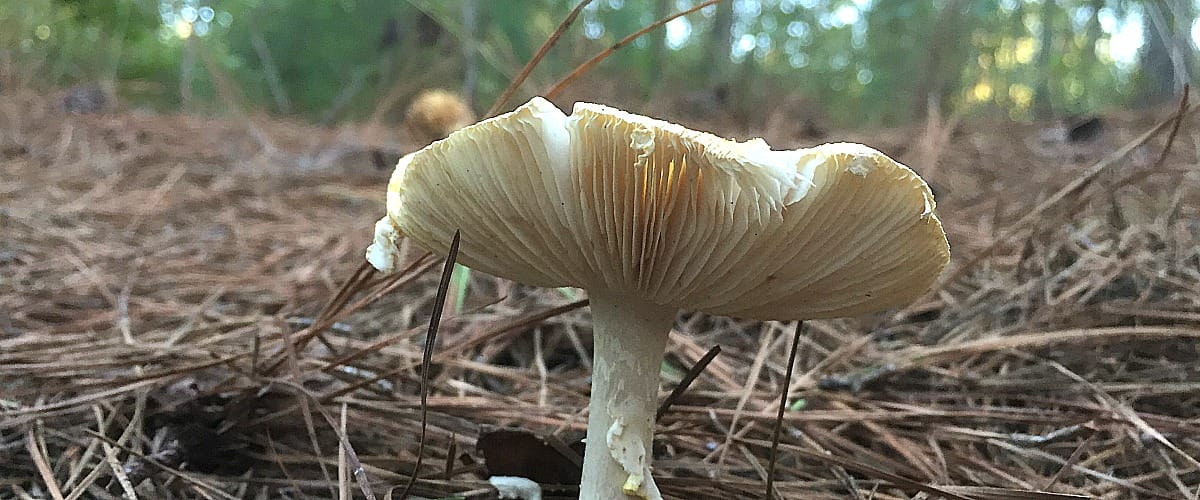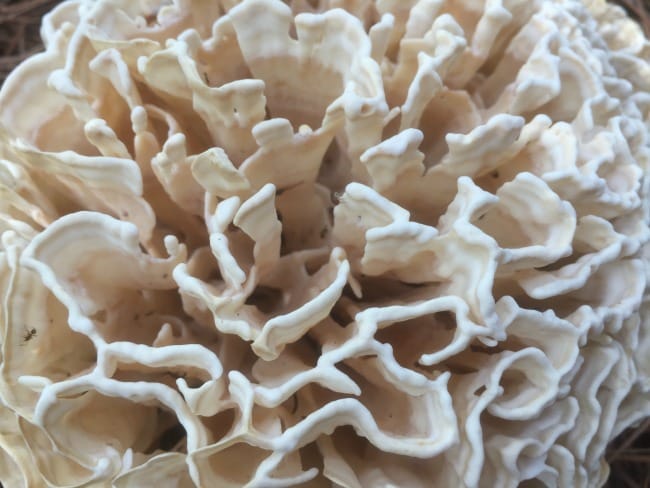

Uh oh...
It appears that you're using a severely outdated version of Safari on Windows. Many features won't work correctly, and functionality can't be guaranteed. Please try viewing this website in Edge, Mozilla, Chrome, or another modern browser. Sorry for any inconvenience this may have caused!
Read More about this safari issue.

Fall weather often brings about the perfect conditions for wild mushroom growth. Moderate daytime temperatures, cooler nights, moisture and lower light mean mushrooms are popping up in forests and yards all over Arkansas. The Arkansas Mycological Society (AMS) often sees an increase in interest in mushroom foraging during this time of the year and again in the spring.

Mushroom foraging is a fascinating hobby for nature lovers young and old. But there is a steep learning curve and some safety precautions that need to be taken into consideration so you can have a safe and successful foray. There is no danger in touching mushrooms, but some can be toxic when eaten. You have to be able to distinguish one mushroom from another and must have a discerning eye as the differences are often extremely subtle. According to Tim Jones of the AMS, “You have to acquire knowledge, but you also have to appreciate the similarities and differences in the characteristics. No one ever learns all mushrooms, but you can learn one at a time.”
Arkansas Mushroom Experts
The Arkansas Mycological Society began in 1981 after founding members Jay Justice and the late Edith Nelson gave a presentation on mushrooms and fungi at Pinnacle Mountain State Park. With only five members in its first year, the society now has 45 active members and an associated Facebook group with over 5000 members.

Jay Justice received degrees in Chemistry and Natural Sciences from the University of Arkansas and is considered by many to be the state’s authority on all things fungal. He is currently serving as the President of the Arkansas Mycological Society, is a former vice-president of the North American Mycological Association (NAMA). He serves as the field mycologist for mycological societies across the southern United States. In 2011 he was the recipient of the NAMA Award for Contributions to Amateur Mycology.

Tim Jones is a lifelong tree hugger and mushroom enthusiast. He became interested in mushrooms after he took a class on growing shiitake mushrooms. Cultivating shiitakes to grow on oak logs sparked an interest that led him to join the AMS where Justice became his mentor.
The pair, known as “The Mushroom Guys,” now provide classes and workshops at local universities and several Arkansas State Parks. They also lead mushroom forays through the AMS several times a year and serve as the moderators for the Arkansas Mushrooms and Fungi Facebook group which provides a learning resource for individuals interested in Arkansas mushrooms and fungi.

Mushrooms Everywhere
September and October have been unusually wet this year, with blocks of cooler temperatures leading to an abundance of mushrooms a bit earlier than normal. Justice says this has led to a blossoming of interest in mushroom foraging, which is evident by the recent increase in requests to join the Arkansas Mushrooms and Fungi Facebook group.
Mushroom foraging attracts people for different reasons. Pothunters are interested in eating wild fungi (we will address this further below), some people are interested in using them to make dyes, some are interested in mushrooms from a taxonomic standpoint — discovering “what’s what,” while others are just interested in the beauty and diversity of the different specimens they find.

Mushrooms are actually the flowering body of a fungus that is growing underground or under soil and other decomposing matter like stumps, branches and leaf litter. When conditions are right, the mushrooms will flourish.
Although the type of mushrooms that you will find can depend on location, tree association, and several other factors, here are examples of several common mushrooms currently occurring across the state:

Learning to Identify Fungi
The Facebook group is a great place to share photos and compare notes with other Arkansans regarding mushroom finds. If you join the group looking for assistance in identification, they have a few suggestions to help you get a more specific identification of your specimen. In addition to taking clear pictures from a variety of angles, you are more likely to get an accurate identification if you note the following:
- Habitat. What trees are in the area? Is the mushroom growing from the ground, from a log, from a pile of manure?
- Time of Year. Some species are more likely to be found in the spring than in the fall and vice versa.
- Cap. The color, shape, size and any markings on the cap are helpful to note.
- Stalk. Make a note of the length, thickness, color or even absence of the stalk.
- Gills/Pores/Teeth. The underside of the mushroom is just as important as the cap when it comes to identification and can be complicated as well. Spacing, stem attachment, color, bruising, etc. are all things that need to be considered.
- Spore Color. The gills produce microscopic spores which help spread the fungus. Spore color can be determined by creating a spore print. (Click here for instructions.)
- Bruising. Some mushrooms will change color or “bruise” when touched or scratched.
- Smell. Mushrooms are similar to fine wines, and each will have a different odor profile. This can range from fruity, to earthy to downright stinky. In addition to aiding in identification, the smell can also indicate the age and quality of a specimen, which can be essential knowledge when dealing with edible mushrooms.
The group moderators also recommend that you carefully dig your specimen, rather than pluck it, as the underground structure of a mushroom can also provide a wealth of information.
Genus is relatively easy to identify but species can be a little tricky, and many species within a genus can be very similar. Proper identification comes from lots of research.

Is it Edible?
Both Jones and Justice say the question they are most often asked is whether or not a particular mushroom is edible. It is also the question that both usually refrain from answering, at least within the Facebook group.
Justice says, “Part of what fuels people’s interest in mushrooms is that they see them as a free source of food. Everyone loves free, but everyone also understands that not all mushrooms are edible. People will post a picture [in the Facebook group] and ask if they can eat the mushroom. There are so many subtle differences that without being able to see, touch and smell the specimen — that’s not a call I’m willing to make.”
While many mushrooms are safe to consume, some mushrooms are extremely toxic. Liver and kidney damage can be life-threatening and can even lead to the need for transplants. Thus, both Jones and Justice recommend that unless you have done your research, or better yet, worked with a well-seasoned mentor, keep the mushrooms out of your kitchen.
“Many people believe that they can just head out into the woods and collect their next meal. Especially, if you are going to be serving others, you have an ethical obligation to get it right. Toxic mistakes are few and far between, but they can and do happen.” Jones continues, “There is no substitute for learning and knowledge. Don’t just set out to learn the edibles, learn the ones you could make a mistake on. It’s what we think we know that can hurt us.”
Jones and Justice agree that the best method of learning is through a mentor. Find someone who is well trained and has years of experience with forays. The AMS is welcoming to new members, and many of their existing members are more than happy to mentor the new guy. You can find information on joining the AMS here.

Foraging for mushrooms is a great hobby and is completely safe if you know what you are doing. Before you even consider eating a wild mushroom, you have a responsibility to learn about the mistakes you can make. And remember, just because it’s on the internet doesn’t mean that it’s true. Do you really want to trust someone you don’t know to identify your mushroom based on a picture that you post online?
Many Arkansas State Parks host mushroom workshops. Check the calendar at your local park or contact the park if you would like to see them host a workshop. Arkansas State Parks do require a permit to forage for mushrooms, so if you are not on an organized foray, it is best to take pictures only or hunt on private property.
Head to the Arkansas Mushroom and Fungi Facebook page for more information. You can learn more about joining the Arkansas Mycological Society here, and you can find a great list of valuable resources here.
Join the Conversation
Leave a Comment
9 responses to “The Surprisingly Exciting World of Arkansas Mushroom Foraging”
 Leave a Reply
Leave a Reply
We do the work.
You check your email.
Sign up for our weekly e-news.
Get stories sent straight to your inbox!











 Leave a Reply
Leave a Reply
[…] For information on foraging mushrooms, please see our article on Arkansas Mushroom Foraging. […]
I found two types of mushrooms.. one I have not seen in Arkansas. I’m located in NEA. May I send you pictures?
[…] The Surprisingly Exciting World of Mushroom Foraging […]
I have been eating these charcoal colored mushrooms in my front yard and actually on my all of my property and today it was getting dark and I found some down in my field where I was mowing and I ate and then I got to thinking about the death cap and I don’t know if I saw everything correctly. I don’t know what kind of been eating I just know they haven’t killed me yet and I’ve been eating them for five or six years I hope someone can tell me what kind those are that I’ve been eating the stem has small no skirt that I can see and they are charcoal colored brownish charcoal.
Probably carbonfibre caps, from genus kingsfordia
Might want to check the bag to make sure, and also survey the neighbors dog..
I didn’t see any information on a class being taught in the area? Is there a class? Because every time I go online to look, it says no classes offered in Arkansas!
I have found something I think is white truffles. They are under ground. When they just barely crack the ground I did them up. I found them down by my old pine trees and under my lawn mower.I broke 1 open, it is white, no gills, the center is slightly greyish.They are like a tuber.I hope they are eatable.I would like your input, please. I know you would like a picture but I’m not really computer literate and don’t know how to do it. I’m in my mid 70’s and computers are difficult for me.
[…] The Surprisingly Exciting World of Arkansas Mushroom Foraging More Than Meets the Eye: Weeds You Can Eat Nuts of Arkansas 10 Wild Edible Plants in Arkansas […]
I found what I think might be Chaga north of Batesville, Arkansas and I harvested a piece and saw more up higher in the tree I could not reach. I looks like the pictures online but only a little bit of the top portion has the orange tint and the rest of it is a dark brown. Could it still be a species of Chaga?